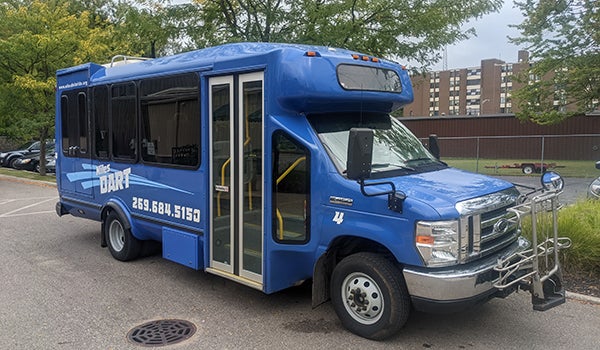Pork producers open up markets overseas
Published 2:08 pm Friday, July 10, 2009
By JOHN EBY / Dowagiac Daily News
One of every five hogs produced is destined for overseas.
“Export markets are doing a tremendous job for us at helping keep pork prices a little bit higher, where our pig farmers need them,” Beth Ferry said.
“We sell a lot to China and Japan, which don’t care how big their pork chop is. They cut everything up into smaller pieces. Huge markets. Also, Russia and Korea. Having one out of every five going overseas really helped us with prices lately.”
She grew up in Dowagiac and graduated from Union High School in 1999.
Her parents, Bob and Pat Franz, taught here.
Her dad retired as Justus Gage Elementary School principal.
“They came from farms, but I didn’t,” she said.
Ferry’s involvement started with showing swine at the Cass County Fair. She loved it even more after working on a hog farm for two summers. She completed internships in North Carolina and in Minnesota.
Ferry, an Extension educator since 2005, graduated from Michigan State University in 2003 with a bachelor’s degree in animal science and helps pork producers all over the state learn new technologies and business practices.
In 2004-2005, Beth managed 4,000 sows for the fourth-largest U.S. pork producer in New Alm, Minn.
Its 170,000-sow operation spans Minnesota, Iowa, Nebraska, South Dakota, Colorado and Illinois.
Fifteen older men worked for Beth.
This winter she travels to Denmark to examine pork production.
“I’m so glad I got involved in agriculture because I absolutely love it,” Ferry said.
She joined the Michigan Pork Producers Association in 2003 and has served on its swine health committee for the past two years. Beth also belongs to Cass County Farm Bureau.
Ferry started at one of the county’s larger operations with 2,400 sows – “2,400 mamas having about 24 pigs a year. They usually have 2 1/2 litters.” Beth once saw a litter with 28 tiny oinkers.
One phase of pork production is farrowing.
Once the animals gestate for three months, three weeks and three days, pigs are born and housed in individual stalls in a commercial unit.
In an outside pasture unit, offspring stay with their mothers for five weeks instead of three. They are bedded with straw and given shade outside.
When piglets get about three weeks old, they ship out to a nursery for about seven weeks.
Once they weigh 50 to 70 pounds, they move on to a finishing barn. It takes 17 finishing barns to support a 2,400-sow facility, so they usually rent space on contract.
Beth married Mark Ferry three months ago and lives on a Berrien County family fruit farm that grows apples, peaches, apricots and cherries.
Cherry season just started, so “from here I get to go to another pork activity, then I get to go home and help clean cherry tanks,” she told Dowagiac Rotary Club Thursday noon at Elks Lodge 889.
Ferry raises about five pigs a year of her own.
“I’m trying to work on my husband to get some more, but he’s not really liking that,” she smiled. “These guys are outside in a pasture. They have a quonset hut and are the friendliest pigs around because right next to them lives our cousin. She runs a daycare. Every day, the kids go out and feed the pigs Oreos. I have very friendly, very fat pigs. I’m also trying to get my husband to start feeding my pigs apples so I can sell apple-flavored pork chops.”
It takes about 5 1/2 months to finish a pig. Feeders are mechanically controlled to refill. It takes six bushels of corn to finish one pig, which consumes eight pounds a day. Eating whatever they want whenever they want packs on 1.7 pounds a day.
Ferry serves a dual role as a pork industry volunteer. “What the industry is trying to do is to get people into different organizations to talk about how we raise pigs. This is part of Operation Main Street and it’s happening all over the United States,” she said. “Our industry has gone through a huge change in the last 20 years, from many different farms, where everyone had a pig, a cow and a sheep, to farms that are more integrated, with only pigs or only cattle.”
Figures show 39,482 farms with less than 100 pigs – 1 percent of production – and 2,466 with 5,000 hogs or more sent to market – 54 percent of production. “Here in Cass County we’re lucky because we have one of the most diverse types of pig operations around,” said Ferry, who grew up on Gage Street in Wayne Township.
Michigan ranks 12th in U.S. pork production.
Cass County for years led the state, but has slipped to third behind Allegan and Ottawa counties, but ahead of Huron and Branch counties.
That came as a surprise to Prosecutor Victor Fitz, who took a good bit of ribbing from colleagues six years ago when he came to the “hog capital of Michigan” from Muskegon. Last summer, of course, diesel fuel cost more than $4 a gallon, plus costs for corn and soybean feed increased. Pork prices had started to rebound a bit, but then came H1N1, the so-called “swine flu,” and “people got a little nervous about pork production,” Ferry said. “For the past year and a half, some of our pig farmers lost $30 for every pig they sold. We fell from No. 1 about four years ago. The number outside has become less. You cannot keep as many in an outside pasture environment as you can in commercial facilities where Allegan and Ottawa have increased quite a bit. And we have dropped a bit. We had some farmers go out of business. The last couple of years have been a little rough.”
Ferry’s PowerPoint presentation, which she gives frequently at schools, visually displays Cass County’s hog farm diversity, starting with a four-barn environmentally-controlled facility on Marcellus Highway which houses pigs as they grow from 50 pounds until they’re ready for market at a long, lean 250.
Environmental control is necessary because pigs prefer 60-degree temperatures – not usually the norm in Michigan in July.
Piglets, however, like it 103 degrees, which is achieved with auxiliary heating mats.
She shows a “hoop facility” on Pokagon Highway, which bears a resemblance to a greenhouse. In fact, she noted, one Marcellus farmer tried to raise petunias in his rounded roof, but “that smell got into the petunias. It’s really hard to sell flowers that smell like pigs, but we tried.”
A farm just over the county line going toward Decatur is a pasture operation.
Another Marcellus operation serves as an example of the smaller farm that “does a little bit of everything. He has pigs inside, outside, he beds them, he has heat for them.”
Another image promotes the interconnectedness of a sow unit with its surroundings, which looks like the hub of a wheel radiating spokes to farm equipment dealers, feed mills, contract producers, trucking of feed and animals, insurance, hardware stores, taxes and banking.
“One single sow unit in an area affects quite a few people and keeps quite a few different people employed,” she said. “We like to think of farmers in the environment as the first natural recyclers. We try to use sound practices that protect our groundwater and our surface water while utilizing nutrients we have. We use scientific standards to test our soil, our air and water and maximize our natural fertilizer use. We breathe the same air you do by those pig farms, so we’re trying to make everything as healthy as we can.”
Manure can be spread by tanker system filled with 4,000 gallons of swine waste knifed nine inches into the ground, reducing odor and placing it into the root zone where corn and soybeans really need nutrients.
When she visits elementary schools to talk about where their food comes from, kids go from thinking milk and bacon come from Wal-Mart instead of cows and pigs. She convinces them pigs don’t stink, they “smell like money.”
Nitrogen and phosphorous, which make up the bulk of manure, cost $550 a ton for the former and $925 a ton for the latter if purchased commercially, compared to $11 and $13 from hog waste.
Relying so much on manure for fertilizer has stunted development of energy from methane digesters.
“We’re working on a regional digester in Allegan County” which will pool manure in a central location. “We will turn that into electricity and sell it back to the grid. Allegan has sky-high phosphorous levels. Cass County’s phosphorous and nitrogen levels are still pretty low so we can spread a lot of manure around.”
The industry has put together some animal care programs.
PQA stands for Pork Quality Assured, which reinforces farmers how to raise safe, healthy and wholesome products.
TQA is directed at truckers, since travel stresses meat quality.
Michigan lacks any large processing plant, which means the closest is a five-hour jaunt over to Sandusky, Ohio, 160 to 170 per semi – or even farther to Missouri or Iowa.
The We Care program stresses five things – animal care, the environment, food safety, health and community.
Acknowledging that Rotary served grilled pork tenderloin, Ferry noted, “Pork tenderloin has less fat in it than skinless chicken breasts.”






